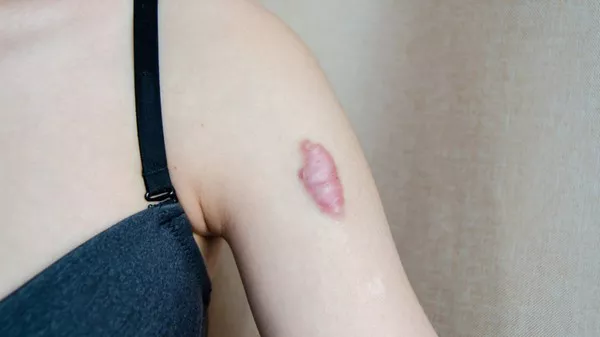Keloids are a type of raised scar that can develop at the site of a wound, injury, or surgical incision. These scars extend beyond the original area of skin damage and can be unsightly, uncomfortable, and even painful for some individuals. While keloids are not harmful to one’s health, they can have a significant impact on a person’s self-esteem and quality of life. In this article, we’ll explore what keloids are, what causes them, and the best ways to treat and manage them effectively.
Understanding Keloids: What Are They?
Keloids are a type of abnormal scar tissue that forms when the body’s healing process goes into overdrive. Unlike normal scars, which typically fade over time, keloids continue to grow beyond the boundaries of the original wound, resulting in a raised, thickened, and often shiny appearance. Keloids can vary in size, shape, and texture, and may be pink, red, or darker than the surrounding skin.
While keloids can develop anywhere on the body, they are most commonly found on the chest, shoulders, earlobes, and upper back. Certain factors, such as genetics, skin type, and the location of the injury, can increase the likelihood of keloid formation.
Causes and Risk Factors
The exact cause of keloids is not fully understood, but several factors are believed to contribute to their development. These include:
Genetics: Individuals with a family history of keloids are more likely to develop them themselves, suggesting a genetic predisposition to the condition.
Skin Type: People with darker skin tones are more susceptible to keloid formation than those with lighter skin tones.
Injury or Trauma: Keloids often form in response to skin injuries, such as cuts, burns, acne scars, surgical incisions, or piercings.
Hormonal Changes: Fluctuations in hormone levels, such as those that occur during puberty, pregnancy, or menopause, can increase the risk of keloid formation.
Age: Keloids are more common in young adults and tend to occur less frequently with advancing age.
Treatment Options for Keloids
While keloids can be challenging to treat, especially in severe cases, there are several options available to help manage symptoms and improve the appearance of the scar. Treatment options for keloids include:
Steroid Injections: Corticosteroid injections are often used to reduce inflammation and shrink keloids. These injections are typically administered directly into the keloid every few weeks until the desired results are achieved.
Surgical Excision: Surgical removal of the keloid may be an option for some patients, particularly if the scar is large or causing significant discomfort. However, surgery carries the risk of keloid recurrence and may be combined with other treatment modalities to minimize this risk.
Cryotherapy: Cryotherapy involves freezing the keloid with liquid nitrogen to destroy the abnormal tissue. This treatment is often used in conjunction with other therapies to prevent keloid recurrence.
Laser Therapy: Laser treatment can help reduce the size and appearance of keloids by targeting the blood vessels that supply them with nutrients. This approach is often used in combination with other treatments for optimal results.
Pressure Dressings: Applying pressure to the keloid with specialized dressings or silicone gel sheets may help flatten the scar and reduce its size over time.
Radiation Therapy: Radiation therapy may be recommended in cases where other treatments have been unsuccessful. This approach involves targeted radiation to the keloid site to prevent recurrence.
Topical Treatments: Certain topical treatments, such as silicone gel or sheets, may help soften and flatten keloid scars when applied regularly over time.
Factors to Consider When Choosing a Treatment
When considering treatment options for keloids, several factors should be taken into account, including:
Severity of the Keloid: The size, location, and thickness of the keloid will influence the choice of treatment and the likelihood of success.
Patient Preferences: Some individuals may prefer non-invasive treatments, such as steroid injections or topical therapies, while others may be open to more aggressive approaches, such as surgery or laser therapy.
Potential Side Effects: Each treatment modality carries its own risks and potential side effects, which should be discussed with a healthcare provider before making a decision.
Cost and Accessibility: Some treatments may be more expensive or less readily available than others, depending on factors such as insurance coverage and geographic location.
Risk of Recurrence: Keloids have a tendency to recur, even after successful treatment. Patients should be aware of the risk of recurrence and discuss strategies for minimizing this risk with their healthcare provider.
Prevention and Self-Care Tips
While keloids cannot always be prevented, there are steps individuals can take to reduce their risk of developing them:
Avoid Trauma to the Skin: Minimize the risk of keloid formation by avoiding unnecessary piercings, tattoos, or other procedures that could injure the skin.
Treat Injuries Promptly: Promptly clean and care for any cuts, burns, or other injuries to the skin to reduce the risk of keloid formation.
Use Sun Protection: Protect the skin from sun exposure, as sunburns can trigger keloid formation or exacerbate existing scars.
Avoid Tight Clothing or Jewelry: Avoid wearing tight clothing or jewelry that could put pressure on the skin and increase the risk of keloid formation.
Follow Post-Treatment Care Instructions: If undergoing treatment for keloids, carefully follow your healthcare provider’s instructions for post-treatment care to optimize results and minimize the risk of recurrence.
Conclusion
Keloids can be a source of discomfort and self-consciousness for those affected by them, but with proper treatment and management, their impact can be minimized. By understanding the causes of keloids and exploring the various treatment options available, individuals can take proactive steps to address these scars and improve their quality of life. If you or someone you know is struggling with keloids, consult with a healthcare provider to discuss the best course of action for managing this condition effectively.
[inline_related_posts title=”You Might Be Interested In” title_align=”left” style=”list” number=”6″ align=”none” ids=”6565,6465,6468″ by=”categories” orderby=”rand” order=”DESC” hide_thumb=”no” thumb_right=”no” views=”no” date=”yes” grid_columns=”2″ post_type=”” tax=””]
































